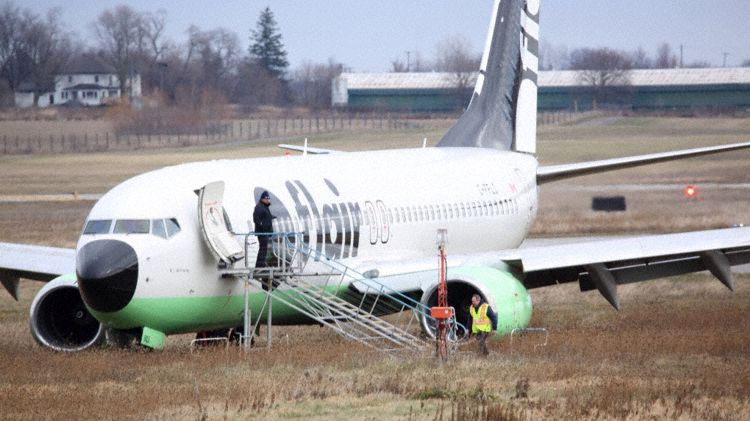Overview
• Operator: Flair Airlines
• Aircraft Model: Boeing 737-800
• Registration: C-FFLC
• Flight Number: F8-501
• Route: Vancouver (Canada) → Kitchener (Canada)
• Date: 25 November 2022
• Time: 06:25L (11:25Z)
• Occupants: 140 (134 passengers, 6 crew)
• Injuries: None
• Aircraft Damage: Minor (left engine FOD damage)
• Nature of Incident: Runway overrun on landing
Incident Summary
Flair Airlines flight F8-501, operated by a Boeing 737-800 (C-FFLC), was performing a scheduled passenger flight from Vancouver to Kitchener when it overran the end of Runway 26 during landing at Kitchener/Waterloo International Airport (CYKF). The aircraft came to a stop approximately 140 meters (470 feet) past the runway threshold on soft ground.
The passengers disembarked via stairs and were transported to the terminal. There were no reported injuries, and the aircraft sustained minor damage, primarily foreign object debris (FOD) damage to the left engine.
Key Findings from the Final Report (TSB – February 13, 2025)
1. Pilot Error – Improper Autothrottle Disengagement
• The captain left the autothrottle engaged after disengaging the autopilot, a habit formed from previous airline experience.
• Shortly before landing, the captain inadvertently pressed the Takeoff/Go-Around (TO/GA) switch instead of disengaging the autothrottle.
• This caused the engines to increase thrust in go-around mode, which went unnoticed by the crew.
2. Fatigue-Induced Error
• The captain was severely fatigued, having accumulated significant sleep debt over the past week.
• At the time of the incident, the captain had been awake for nearly 18 hours, affecting decision-making and reaction times.
3. Thrust Asymmetry on Landing
• The left thrust reverser was locked in the stowed position due to a pre-existing mechanical issue, meaning only the right reverser deployed.
• As the captain selected reverse thrust on the right engine, the left forward thrust lever advanced due to the autothrottle, resulting in one engine in full reverse thrust and the other producing forward thrust.
4. Disabling of Auto-Brake and Speed Brake Systems
• The left engine’s forward thrust caused the speed brakes to retract, significantly reducing braking efficiency.
• The auto-braking system was deactivated, further compromising the aircraft’s stopping performance.
5. Late Manual Braking Attempt
• By the time maximum manual braking was applied, the aircraft had only 2,500 feet of runway remaining while still traveling at 115 knots.
• Given the wet runway conditions, this was insufficient to prevent an overrun.
Sequence of Events
1. Final Approach:
• The crew followed normal approach procedures, except the captain mistakenly left the autothrottle engaged.
• The captain attempted to disengage the autothrottle but accidentally activated the TO/GA switch, causing both engines to spool up for a go-around.
2. Landing & Initial Rollout:
• The aircraft touched down with the right thrust reverser deployed, while the left engine continued to generate forward thrust.
• The auto-brake and speed brake systems disengaged due to the thrust asymmetry.
3. Runway Overrun:
• The aircraft failed to decelerate as expected.
• With insufficient braking force and continued forward thrust, the aircraft exceeded the runway end and stopped on soft ground.
TSB’s Probable Causes
1. Fatigue-Induced Mistakes
• The captain’s fatigue reduced vigilance, increasing the likelihood of pilot errors such as pressing the wrong switch.
2. Lack of Crew Awareness of System Status
• The crew failed to recognize the unintentional TO/GA activation due to low-salience visual and aural cues.
3. Pre-Existing Mechanical Issues
• The left thrust reverser had been inoperative for six months, reported 23 times without a permanent fix.
• The airline’s maintenance tracking system did not classify the issue as a “recurring defect”, delaying resolution.
4. Flawed Autothrottle Design & System Conflicts
• The autothrottle allowed forward and reverse thrust to operate simultaneously, leading to asymmetric braking.
• The lack of an aural warning for autothrottle disengagement contributed to the crew’s failure to detect the TO/GA activation.
Safety Recommendations & Risk Mitigation
✅ Pilot Training & SOP Standardization
• Airlines should strictly enforce standard operating procedures (SOPs) regarding autothrottle and autopilot disengagement.
• Emphasize recognition and correction of TO/GA activation errors.
✅ Fatigue Management
• Enhanced crew scheduling policies to prevent excessive wake times before flight duty.
• Increase awareness and self-monitoring for fatigue symptoms among pilots.
✅ Maintenance & Recurring Defect Tracking
• Airlines must improve defect tracking systems to catch persistent but non-critical maintenance issues before they contribute to incidents.
• The Flair left thrust reverser issue had been reported 23 times over 6 months, but no permanent fix was implemented.
✅ Aircraft System Improvements
• Boeing should modify autothrottle logic to automatically disengage if reverse thrust is selected.
• Improve cockpit annunciations for TO/GA activation to ensure pilots immediately recognize unintended mode changes.
Conclusion
This runway overrun was entirely preventable. It resulted from a combination of pilot error, fatigue, and overlooked maintenance issues. The captain’s inadvertent TO/GA activation, coupled with a long-standing thrust reverser defect, caused an asymmetric braking scenario that made stopping on the available runway impossible.
Flair Airlines’ maintenance tracking system failed to flag recurring defects, and pilot fatigue was not adequately managed. The airline, aircraft manufacturer, and regulatory authorities must address these issues to prevent similar future incidents.
Disclaimer
This report is based on publicly available information as of 13 February 2025. While every effort has been made to ensure accuracy, we cannot guarantee the completeness of the details. If you are the rightful owner of any referenced materials and wish for them to be removed, please email takedown@cockpitking.com.
